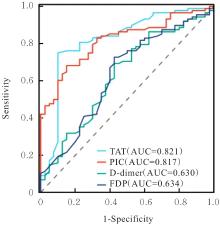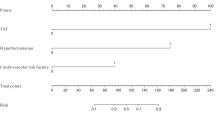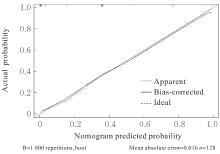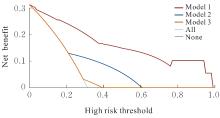Journal of Jilin University(Medicine Edition) ›› 2024, Vol. 50 ›› Issue (5): 1390-1399.doi: 10.13481/j.1671-587X.20240524
• Research in clinical medicine • Previous Articles
Predictive value of new thrombotic risk assessment model for venous thromboembolism in patients with malignant tumors
Honghong LI1,Na YU1,Minghao SHI1,Ying SUN2,Yao LI1,Zhongjun SHEN1,Xiaoyi LIU1,Liyan ZHAO1( )
)
- 1.Department of Blood Transfusion, Second Hospital, Jilin University, Changchun 130041, China
2.Department of Clinical Laboratory, Second Hospital, Jilin University, Changchun 130041, China
-
Received:2023-12-20Online:2024-09-28Published:2024-10-28 -
Contact:Liyan ZHAO E-mail:zhaoliy@jlu.edu.cn
CLC Number:
- R730.6
Cite this article
Honghong LI,Na YU,Minghao SHI,Ying SUN,Yao LI,Zhongjun SHEN,Xiaoyi LIU,Liyan ZHAO. Predictive value of new thrombotic risk assessment model for venous thromboembolism in patients with malignant tumors[J].Journal of Jilin University(Medicine Edition), 2024, 50(5): 1390-1399.
share this article
Tab. 1
General data of patients in VTE group and non-VTE group"
| Variable | VTE group (n=40) | Non-VTE group (n=88) | t/F/U | P |
|---|---|---|---|---|
| Age(year) | 61.73±10.41 | 58.91±13.40 | 1.168 | 0.245 |
| Male(percentage of man) | 16(40.00) | 30(34.09) | 0.417 | 0.518 |
| BMI(kg·m-2) | 23.52±3.26 | 23.00±3.27 | 0.825 | 0.441 |
| Hypofractionation[n(η/%)] | 16(40.00) | 10(11.36) | 13.932 | <0.001 |
| Lymphatic metastasis[n(η/%)] | 17(42.50) | 21(23.86) | 4.576 | 0.032 |
| Distant metastasis[n(η/%)] | 17(42.50) | 32(36.36) | 0.438 | 0.508 |
| Cardiovascular risk factors[n(η/%)] | 20(50.00) | 13(14.77) | 17.835 | <0.001 |
| Lung cancer[n(η/%)] | 15(37.50) | 32(36.36) | 0.015 | 0.902 |
| Colorectal cancer[n(η/%)] | 13(32.50) | 26(29.55) | 0.113 | 0.736 |
| Ovarian cancer[n(η/%)] | 12(30.00) | 30(34.09) | 0.209 | 0.648 |
| D-dimer(mg·L-1) | 1.17(0.46-2.63) | 0.61(0.38-1.23) | -2.370 | 0.018 |
| FDP(mg·L-1) | 5.40(3.20-8.60) | 3.60(3.00-5.00) | -2.681 | 0.007 |
| TAT(μg·L-1) | 0.93(0.80-1.05) | 0.55(0.46-0.76) | -5.341 | <0.001 |
| PIC(μg·L-1) | 39.97(34.25-43.25) | 21.74(12.90-35.67) | -5.742 | <0.001 |
Tab. 2
Treatment modalities for different types of malignant tumor patient in VTE and non-VTE group"
| Tumor type | Treatment modality | n | VTE group | Non-VTE group | F | P |
|---|---|---|---|---|---|---|
| Lung cancer | Lobectomy | 8 | 2(25.00) | 6(75.00) | 0.212 | 0.645 |
| Lobectomy+lymph node dissection | 10 | 4(40.00) | 6(60.00) | 0.382 | 0.536 | |
Total lung resection+platinum-containing two-drug chemotherapy (single-cycle regimen) | 29 | 9(31.03) | 20(68.97) | 0.027 | 0.869 | |
| Colorectal cancer | Local excision | 27 | 9(33.33) | 18(66.67) | 0.000 | 1.000 |
| Miles+Xelox | 5 | 2(40.00) | 3(60.00) | 0.115 | 0.735 | |
| Miles+Folfox6 | 4 | 1(25.00) | 3(75.00) | 0.139 | 0.709 | |
| Hartmann+Folfox6 | 3 | 1(33.33) | 2(66.67) | 0.000 | 1.000 | |
| Ovarian cancer | Tumor reduction surgery | 20 | 4(20.00) | 16(80.00) | 1.375 | 0.241 |
Tumor reduction surgery+paclitaxel(single-cycle regimen)+carboplatin(single-cycle regimen) | 22 | 8(36.36) | 14(63.64) | 1.375 | 0.241 |
Tab. 4
Diagnostic efficacies of different biomarkers analyzed by ROC curve"
| Variable | Cut-off value | Sensitivity(η/%) | Specificity(η/%) | Youden index | AUC | 95%CI of AUC |
|---|---|---|---|---|---|---|
| TAT | 0.695 | 75.0 | 90.0 | 0.650 | 0.821 | 0.735-0.906 |
| PIC | 31.257 | 68.2 | 85.0 | 0.532 | 0.817 | 0.745-0.890 |
| D-dimer | 1.050 | 57.5 | 69.3 | 0.268 | 0.630 | 0.525-0.735 |
| FDP | 5.150 | 57.5 | 72.7 | 0.302 | 0.634 | 0.529-0.740 |
Tab. 6
Correlation analysis among variables"
| Variable | r | ||||
|---|---|---|---|---|---|
| TAT≥0.70 μg·L-1 | PIC≥31.26 μg·L-1 | Hypofractionation | Lymphatic metastasis | Cardiovascular risk factor | |
| TAT≥ 0.70 μg·L-1 | 1.000 | -0.637 | 0.081 | 0.050 | 0.115 |
| PIC≥ 31.26 μg·L-1 | -0.637 | 1.000 | 0.468 | 0.034 | 0.146 |
| Hypofractionation | 0.081 | 0.468 | 1.000 | 0.151 | 0.112 |
| Lymphatic metastasis | 0.050 | 0.034 | 0.151 | 1.000 | 0.029 |
| Cardiovascular risk factors | 0.115 | 0.146 | 0.112 | 0.029 | 1.000 |
Tab. 7
Results of Multivariate Logistic regression analysis"
| Variable | β | SE | Wald | OR | 95%CI | P |
|---|---|---|---|---|---|---|
| TAT≥0.70 μg·L-1 | 3.062 | 1.435 | 4.556 | 21.387 | 1.285-356.097 | 0.033 |
| PIC≥31.26 μg·L-1 | 1.887 | 1.473 | 1.642 | 6.601 | 0.368-118.352 | 0.200 |
| Hypofractionation | 3.751 | 1.232 | 9.268 | 42.548 | 3.804-475.968 | 0.002 |
| Lymphatic metastasis | 0.661 | 0.597 | 1.226 | 1.938 | 0.601-6.247 | 0.268 |
| Cardiovascular risk factors | 1.912 | 0.653 | 8.570 | 6.770 | 1.882-24.357 | 0.003 |
| 1 | LEVINE M. Treatment of thrombotic disorders in cancer patients[J]. Haemostasis, 1997, 27(): 38-43. |
| 2 | MOIK F, CHAN W E, WIEDEMANN S, et al. Incidence, risk factors, and outcomes of venous and arterial thromboembolism in immune checkpoint inhibitor therapy[J]. Blood, 2021, 137(12): 1669-1678. |
| 3 | KHORANA A A, KUDERER N M, MCCRAE K, et al. Cancer associated thrombosis and mortality in patients with cancer stratified by khorana score risk levels[J]. Cancer Med, 2020, 9(21): 8062-8073. |
| 4 | ABDULLA A, DAVIS W M, RATNAWEERA N, et al. A meta-analysis of case fatality rates of recurrent venous thromboembolism and major bleeding in patients with cancer[J]. Thromb Haemost, 2020, 120(4): 702-713. |
| 5 | LYMAN G H, CULAKOVA E, PONIEWIERSKI M S, et al. Morbidity, mortality and costs associated with venous thromboembolism in hospitalized patients with cancer[J]. Thromb Res, 2018, 164(): S112-S118. |
| 6 | HUSSEINZADEH H, CARRIER M. Occult cancer detection in patients with hemostatic disorder and venous thromboembolism[J]. Thromb Res, 2018, 163: 242-245. |
| 7 | GRILZ E, POSCH F, NOPP S, et al. Relative risk of arterial and venous thromboembolism in persons with cancer vs. persons without cancer-a nationwide analysis[J]. Eur Heart J, 2021, 42(23): 2299-2307. |
| 8 | DEBBIE JIANG M D, ALFRED IAN LEE M D. Thrombotic risk from chemotherapy and other cancer therapies[J]. Cancer Treat Res, 2019, 179: 87-101. |
| 9 | MOIK F, AY C, PABINGER I. Risk prediction for cancer-associated thrombosis in ambulatory patients with cancer: past, present and future[J]. Thromb Res, 2020, 191(): S3-S11. |
| 10 | LI M, GUO Q, HU W M. Incidence, risk factors, and outcomes of venous thromboembolism after oncologic surgery: a systematic review and meta-analysis[J]. Thromb Res, 2019, 173: 48-56. |
| 11 | PASTORI D, CORMACI V M, MARUCCI S, et al. A comprehensive review of risk factors for venous thromboembolism: from epidemiology to pathophysiology[J]. Int J Mol Sci, 2023, 24(4): 3169. |
| 12 | TAXBRO K, HAMMARSKJÖLD F, THELIN B, et al. Clinical impact of peripherally inserted central catheters vs implanted port catheters in patients with cancer: an open-label, randomised, two-centre trial[J]. Br J Anaesth, 2019, 122(6): 734-741. |
| 13 | CHEW H K, WUN T, HARVEY D, et al. Incidence of venous thromboembolism and its effect on survival among patients with common cancers[J]. Arch Intern Med, 2006, 166(4): 458-464. |
| 14 | KAKKAR A K, WILLIAMSON R C. Thromboprophylaxis in malignant disease[J]. Br J Surg, 1995, 82(6): 724-725. |
| 15 | SPYROPOULOS A C, ELDREDGE J B, ANAND L N, et al. External validation of a venous thromboembolic risk score for cancer outpatients with solid tumors: the COMPASS-CAT venous thromboembolism risk assessment model[J]. 2020, 25(7): e1083-e1090. |
| 16 | FALANGA A, AY C, DI NISIO M, et al. Venous thromboembolism in cancer patients: ESMO Clinical Practice Guideline[J]. Ann Oncol, 2023, 34(5): 452-467. |
| 17 | ABDEL-RAZEQ H, SHARAF B, AL-JAGHBEER M J, et al. COMPASS-CAT versus Khorana risk assessment model for predicting venous thromboembolic events in patients with non-small cell lung cancer on active treatment with chemotherapy and/or immunotherapy, the CK-RAM study[J]. J Thromb Thrombolysis, 2023, 56(3): 447-453. |
| 18 | GEROTZIAFAS G T, TAHER A, ABDEL-RAZEQ H, et al. A predictive score for thrombosis associated with breast, colorectal, lung, or ovarian cancer: the prospective COMPASS-cancer-associated thrombosis study[J]. Oncologist, 2017, 22(10): 1222-1231. |
| 19 | WANG Y F, MA F, LIU B L, et al. Risk prediction of venous thromboembolism in non-small cell lung cancer patients based on COMPASS-CAT risk assessment model[J]. Chin J Oncol, 2020, 42(4): 340-345. |
| 20 | DETTERBECK F C, CHANSKY K, GROOME P, et al. The IASLC lung cancer staging project: methodology and validation used in the development of proposals for revision of the stage classification of NSCLC in the forthcoming (eighth) edition of the TNM classification of lung cancer[J]. J Thorac Oncol, 2016, 11(9): 1433-1446. |
| 21 | YANG L, CHEONG N, WANG D Y, et al. Generation of monoclonal antibodies against Blo t 3 using DNA immunization with in vivo electroporation[J]. Clin Exp Allergy, 2003, 33(5): 663-668. |
| 22 | MEI H, JIANG Y, LUO L L, et al. Evaluation the combined diagnostic value of TAT, PIC, tPAIC, and sTM in disseminated intravascular coagulation: a multi-center prospective observational study[J]. Thromb Res, 2019, 173: 20-26. |
| 23 | KINASEWITZ G T, ZEIN J G, LEE G L, et al. Prognostic value of a simple evolving disseminated intravascular coagulation score in patients with severe sepsis[J]. Crit Care Med, 2005, 33(10): 2214-2221. |
| 24 | DHAINAUT J F, SHORR A F, MACIAS W L, et al. Dynamic evolution of coagulopathy in the first day of severe sepsis: relationship with mortality and organ failure[J]. Crit Care Med, 2005, 33(2): 341-348. |
| 25 | ZHOU K, ZHANG J, ZHENG Z R, et al. Diagnostic and prognostic value of TAT, PIC, TM, and t-PAIC in malignant tumor patients with venous thrombosis[J]. Clin Appl Thromb Hemost, 2020, 26: 1076029620971041. |
| 26 | ZHAO X X, YANG S Y, LEI R N, et al. Clinical study on the feasibility of new thrombus markers in predicting massive cerebral infarction[J]. Front Neurol, 2023, 13: 942887. |
| 27 | LUNDBECH M, KRAG A E, CHRISTENSEN T D, et al. Thrombin generation, thrombin-antithrombin complex, and prothrombin fragment F1+2 as biomarkers for hypercoagulability in cancer patients[J]. Thromb Res, 2020, 186: 80-85. |
| 28 | LING L Q, HUANG X B, LIU C N, et al. Monitoring coagulation-fibrinolysis activation prompted timely diagnosis of hemophagocytic lymphohistiocytosis-related disseminated intravascular coagulation[J]. Thromb J, 2021, 19(1): 82. |
| 29 | YAMADA S, ASAKURA H. Management of disseminated intravascular coagulation associated with aortic aneurysm and vascular malformations[J]. Int J Hematol, 2021, 113(1): 15-23. |
| 30 | SONG P P, XIE J Q, LI W, et al. Effect of plasma thrombin-antithrombin complex on ischemic stroke: a systematic review and meta-analysis[J]. Syst Rev, 2023, 12(1): 17. |
| 31 | CUI C J, GAO J, LI J, et al. Value of TAT and PIC with D-dimer for cancer patients with metastasis[J]. Int J Lab Hematol, 2020, 42(4): 387-393. |
| 32 | LIU Y E, MA J T, SHI Q Y, et al. Quantitatively monitoring acute ischemic stroke patients post recombinant tissue plasminogen activator treatment[J]. Health Sci Rep, 2021, 4(1): e218. |
| 33 | KEY N S, KHORANA A A, KUDERER N M, et al. Venous thromboembolism prophylaxis and treatment in patients with cancer: ASCO clinical practice guideline update[J]. J Clin Oncol, 2020, 38(5): 496-520. |
| 34 | GALMICHE A, RAK J, ROUMENINA L T, et al. Coagulome and the tumor microenvironment: an actionable interplay[J]. Trends Cancer, 2022, 8(5): 369-383. |
| [1] | Jiaxin YI,Yangyu ZHANG,Yingli FU,Yuchen PAN,Yongjie HAN,Jing JIANG,Yanhua WU. Effect of MEIS1 expression on survival in patients after radical gastrectomy and its value in prognostic evaluation [J]. Journal of Jilin University(Medicine Edition), 2024, 50(5): 1358-1364. |
| [2] | Jinlian LI,Lanzhen HUANG,Xishi HUANG,Kangzhi LI,Jiali JIANG,Miaomiao ZHANG,Qunying WU. Bioinformatics analysis on key genes related to prognosis, diagnosis, and immune cell infiltration of hepatocellular carcinoma and their potential therapeutic drugs [J]. Journal of Jilin University(Medicine Edition), 2024, 50(4): 1062-1075. |
| [3] | Yufei FENG,Shan JIN,Yubing WANG,Yinfei LU,Lijuan PANG,Kejian LIU. Bioinformatics analysis based on immune-related genes and immune cell infiltration of in-stent restenosis after percutaneous coronary intervention [J]. Journal of Jilin University(Medicine Edition), 2024, 50(3): 749-758. |
| [4] | Peng QI,Xianying MENG,Meihua PIAO,Qiang ZHANG. Network Meta-analysis on risk factors of recurrence of papillary thyroid microcarcinoma [J]. Journal of Jilin University(Medicine Edition), 2023, 49(6): 1504-1512. |
| [5] | Xiunan FENG,Lu CHEN,Yu LONG,Zhenyu JIANG,Ling ZHAO. Analysis on clinical characteristics and risk factors of patients with Sjogren’s syndrome complicated with interstitial lung disease [J]. Journal of Jilin University(Medicine Edition), 2023, 49(6): 1513-1518. |
| [6] | Xue DONG, Jinfeng ZANG, Caifeng XU, Hebing LIU, Zhaohua CHENG. Construction and validation of risk prediction model of enteral nutrition feeding intolerance of patients with severe acute pancreatitis [J]. Journal of Jilin University(Medicine Edition), 2023, 49(6): 1586-1592. |
| [7] | Tong SHEN,Yang WANG,Wei JIN,Zhihui LIN,Li YAN. Risk factors analysis and risk model construction of cognitive frailty in elderly patients with chronic diseases [J]. Journal of Jilin University(Medicine Edition), 2023, 49(5): 1304-1309. |
| [8] | Mingfei JU,Chao LIU,Zhigang MA,Juan ZHAO,Tu WANG,Zhihao WANG. Predictive value of residual cholesterol in occurrence of patients with acute coronary syndrome [J]. Journal of Jilin University(Medicine Edition), 2023, 49(3): 765-769. |
| [9] | Lianyuan WANG,Yi YANG,Huiwen CONG,Haohua WANG,Qihan BAO,Chengsheng LI,Liwen ZHOU,Zichen DING,Yanli LI,Fuyan SHI,Suzhen WANG. Bayesian quantile regression joint model analysis on risk factors of Alzheimer’s disease in people with different MMSE scores [J]. Journal of Jilin University(Medicine Edition), 2023, 49(2): 395-401. |
| [10] | Haiwei QUAN,Yali ZHANG,Han WANG,Yijiu AI,Yutong ZOU,Wei XIA. Detection of expression level of miR-4286 in exosome in peripheral blood of patients with acute myeloid leukemia and its diagnostic value [J]. Journal of Jilin University(Medicine Edition), 2023, 49(2): 460-466. |
| [11] | Shan GAO,Yutong WANG,Minqiu LU,Lei SHI,Bin CHU,Yuehua DING,Mengzhen WANG,Li BAO. Analysis on causes for early death and its risk factors of patients with multiple myeloma in era of novel drugs [J]. Journal of Jilin University(Medicine Edition), 2022, 48(3): 783-789. |
| [12] | Min WANG,Pengyue YU,Yan WANG,Yanke SONG,Yao LI,Ying SUN,Liyan ZHAO. Evaluation values of peripheral blood coagulation indexes, platelet count and NLR in coagulation state in patients with malignant tumors before treatment [J]. Journal of Jilin University(Medicine Edition), 2022, 48(1): 203-210. |
| [13] | Weihang LI,Ziyi DING,Dong WANG,Yikai PAN,Yuhui LIU,Shilei ZHANG,Jing LI,Ming YAN. Bioinformatics analysis based on screening of core driving genes in osteosarcoma and construction of gene model for prediction of survival time of patients [J]. Journal of Jilin University(Medicine Edition), 2021, 47(6): 1570-1580. |
| [14] | Cong WANG, Xiu GUO, Hao CHI, Jie ZHANG, Mingyu XU, Chunling DONG. Application values of simplified Wells score, revised Geneva score and D-dimer level in diagnosis of malignant tumor complicated with pulmonary thromboembolism [J]. Journal of Jilin University(Medicine Edition), 2021, 47(3): 707-713. |
| [15] | ZHANG Haolong, YU Zhentao, GAO Zihan, WU Yuanyu, FANG Xuedong. Related risk factors and clinical treatment of patients with PGS after gastric cancer operation [J]. Journal of Jilin University(Medicine Edition), 2019, 45(03): 673-677. |
|
||











